When it comes to eye conditions, few are as mysterious as glaucoma. As one of the leading causes of blindness in people over the age of 60, glaucoma is a silent thief of sight. When left untreated, glaucoma will lead to permanent blindness.
What Is Glaucoma?
Glaucoma is a group of eye conditions that causes damage to the optic nerve. The optic nerve is the part of the eye that passes impulses to the brain. The brain then translates these impulses into the images that we see. When the optic nerve becomes damaged, nerve impulses are not sent to the brain properly. This leads to vision loss.
Development of Glaucoma
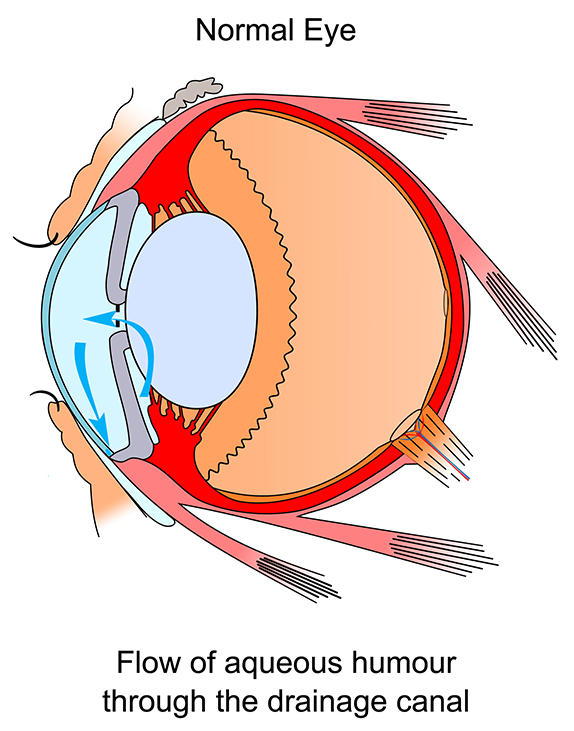
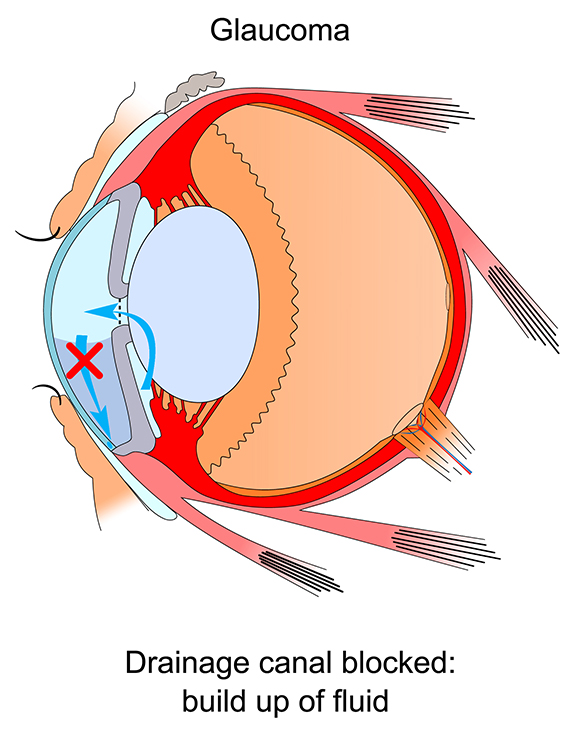
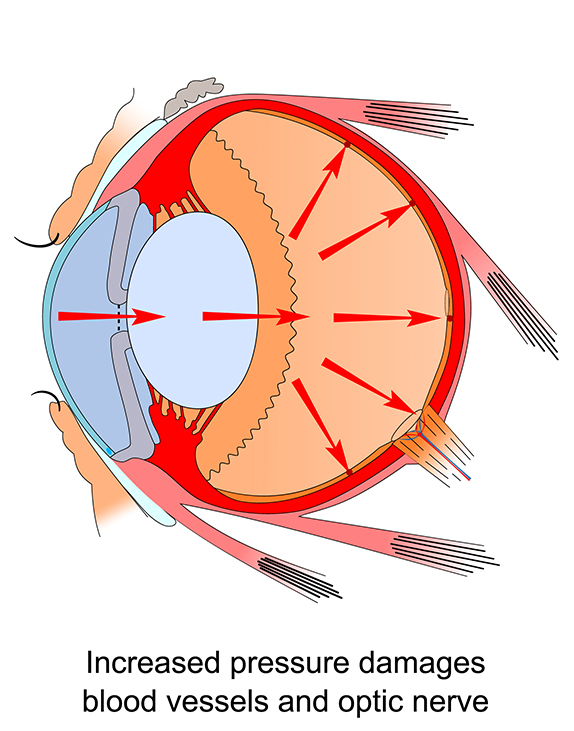
With glaucoma, damage to the optic nerve occurs when intraocular pressure is too high. Increased intraocular pressure often happens when there is a buildup of fluid in the eye. With too much fluid, intraocular pressure goes up and causes optic nerve damage. Once the optic nerve is damaged, vision loss is not reversible. If glaucoma is caught in the early stages, future vision loss is avoidable.
Different Kinds of Glaucoma
Since glaucoma is a group of eye conditions, there are several different kinds. There are two main types: primary open-angle glaucoma and angle-closure glaucoma.
Primary open-angle glaucoma
Primary open-angle glaucoma is the most common kind of glaucoma. This kind of glaucoma forms slowly over time, and starts with no visible symptoms. Primary open-angle glaucoma happens because the eye cannot drain fluids well enough. Over time, the eye becomes less and less able to drain fluids from the eye. This eventually leads to increased intraocular pressure. This then leads to permanent optic nerve damage and vision loss. There is no pain associated with vision loss from primary open-angle glaucoma.
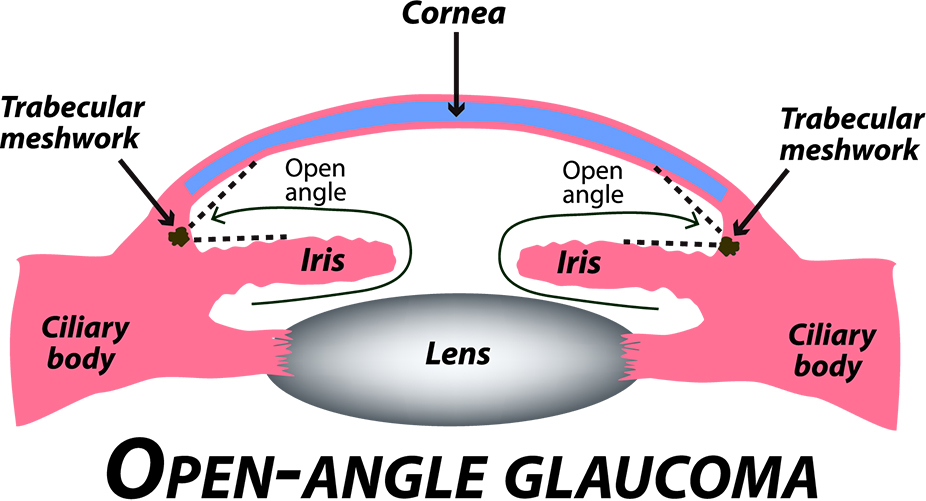
Angle-closure glaucoma
The second most common type of glaucoma is angle-closure glaucoma. Unlike primary open-angle glaucoma, angle-closure glaucoma can come on fast, or slow. When it develops slowly, it is chronic angle-closure glaucoma. For most people with angle-closure glaucoma, it comes on slowly and over time. This type of glaucoma occurs when the iris gets too close to the eye’s drainage angle. When this happens, the iris could end up blocking the drainage angle completely. If the drainage angle is blocked, eye pressure increases quickly. When this occurs, it is known as an acute attack. An acute attack of angle-closure glaucoma is a true eye emergency! If it is not caught and treated, it can lead to blindness.
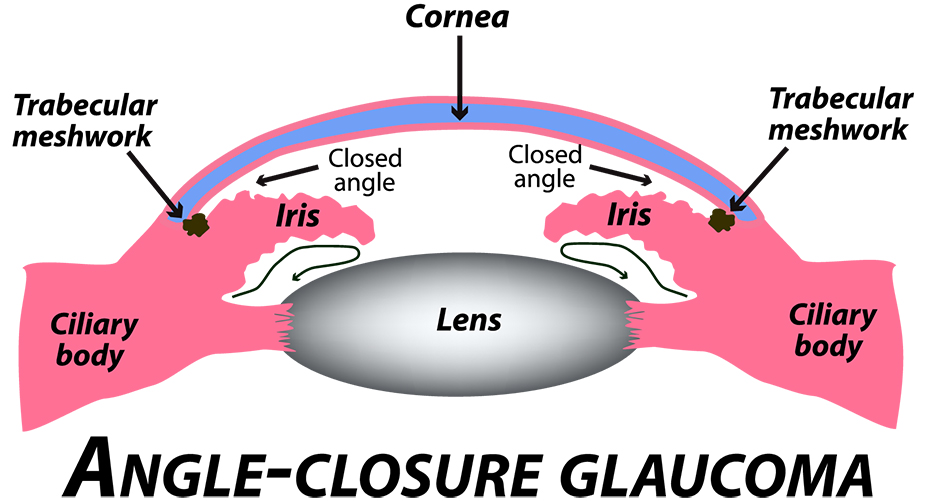
Common symptoms of an acute attack of angle-closure glaucoma include:
- Nausea
- severe eye pain
- blurry vision that comes on suddenly
- Headache
- Vomiting
- seeing halos or rainbow colored rings around lights
For many with chronic angle-closure glaucoma, there are no symptoms. Symptoms only occur during an acute attack, or enough damage affects the optic nerve. If you think you are having an acute attack of glaucoma, immediately call an eye doctor! It could be the difference between vision and blindness.
Symptoms of Glaucoma

With a nickname like the silent thief of sight, it may seem like there are no symptoms of glaucoma, but there are. Part of the difficulty with glaucoma is these symptoms are subtle and easy to ignore. For many patients with glaucoma, a diagnosis comes after vision loss has begun.
With open-angle glaucoma, there are no symptoms, at least in the early stages. For patients with this glaucoma, seeing blind spots peripherally is their first symptom. As open-angle glaucoma progresses, peripheral blind spots and vision loss only get worse. With so few symptoms to watch out for with glaucoma, regular eye exams become even more important! Only an ophthalmologist can diagnose you with glaucoma. Like other medical conditions, the earlier glaucoma is diagnosed, the better. Although there is no cure for glaucoma, intraocular pressure is controllable.
If intraocular pressure stays consistent, further vision loss is avoidable. It’s important to disclose if you have a family history of glaucoma to your eye doctor. Those with a family history of the condition are at a higher risk of developing glaucoma. These patients should have regular eye exams and may need more frequent visits.
Diagnosing Glaucoma
When it is diagnosed in the early stages, further vision loss is avoidable with glaucoma. It’s important to always have regular eye exams with your eye doctor.
A comprehensive eye exam is the only way you can diagnose glaucoma. An eye exam that only checks your eye pressure is not enough. During a glaucoma screening, your ophthalmologist will:
- measure corneal thickness
- measure your intraocular (eye) pressure
- check your optic nerve for any damage
- examine your peripheral vision
- take a picture of your optic nerve
- look at the drainage angle of your eye
Glaucoma Treatment in Livingston
If you get a glaucoma diagnosis, the next step is treatment. The most important part of treatment is preserving vision and preventing further vision loss.
Eye Drops

For early stages of glaucoma, your eye doctor will start you off with eye drops. These eye drops aim to lower intraocular pressure and stabilize it. The drops reduce the amount of fluid produced by the eye.
For some patients, this is enough. Eye drops for glaucoma can adversely affect some patients with negative side effects. There are other oral medications you can try instead that work the same way eye drops do, with fewer side effects.
Laser Procedures
If eye drops are not enough, or if your glaucoma is more advanced, you may undergo a laser procedure. The most common laser procedures for glaucoma are either a trabeculoplasty or an iridotomy. These procedures help excess fluid drain out of the eye.
A trabeculoplasty is for patients with open-angle glaucoma. Your eye doctor uses a laser to improve the drainage angle of your eye. This helps make sure fluid is flowing properly out of the eye. By reducing the amount of fluid in the eye, intraocular pressure is also reduced.
An iridotomy is only performed on patients with angle-closure glaucoma. Like a trabeculoplasty, a laser is used. Instead of improving the drainage angle, the laser creates a small hole in the iris of your eye. With this tiny hole, fluid in the eye can flow to the drainage angle as it should.
Living with Glaucoma

With proper treatment, patients can live a long life with glaucoma. There is currently no cure for glaucoma, so it is a chronic condition. It’s important to realize that glaucoma requires continuous treatment. If you stop taking the medications prescribed, you could start experiencing more vision loss. The most common symptoms that patients have with glaucoma are blind spots in your vision. With severe glaucoma, these blind spots could take a significant amount of vision.
Stay Healthy
If you have glaucoma, try to keep active! Though you cannot reverse the effects of glaucoma, a healthy body helps keep your eyes stable. This includes a diet that’s high in antioxidants like leafy greens or omega-3 fatty acids. Keep an eye on your caffeine intake, as it can increase your eye pressure. This is especially true if you drink coffee!
In some cases, drinking coffee is good for you, but with glaucoma, it’s definitely not. For the sake of your eyes, it’s best to stop drinking all caffeine, including coffee if you have glaucoma. If you are starting a new exercise regimen, be aware. Some activities can actually increase your intraocular pressure. Make sure to talk to your eye doctor about what might be best for you and your needs.
Have more questions about glaucoma?
Schedule an appointment with Associates in Ophthalmology in Livingston, New Jersey today!

